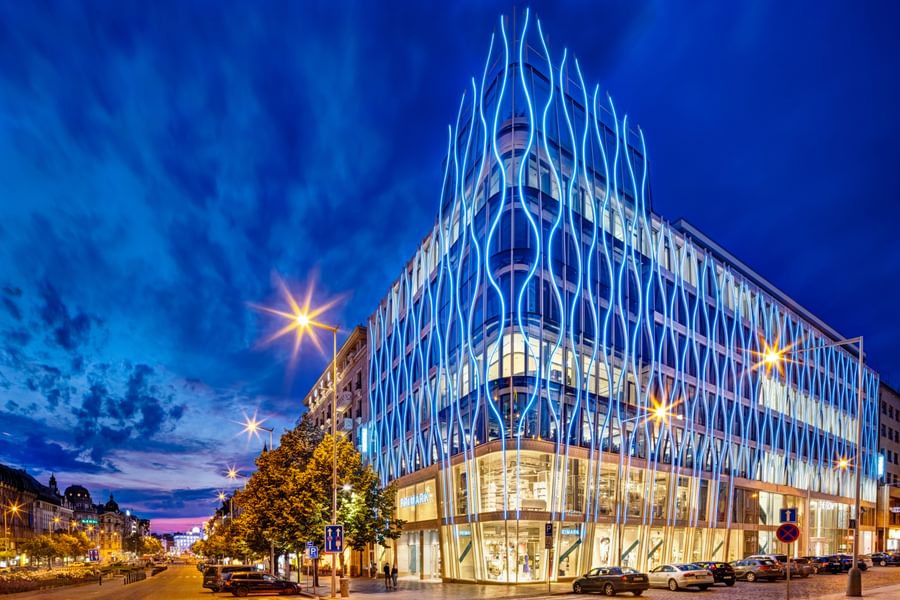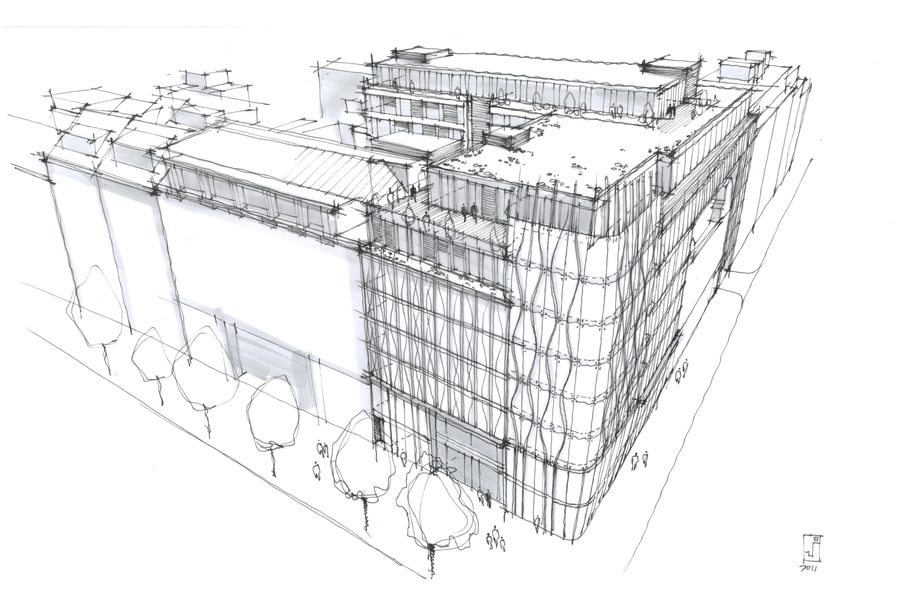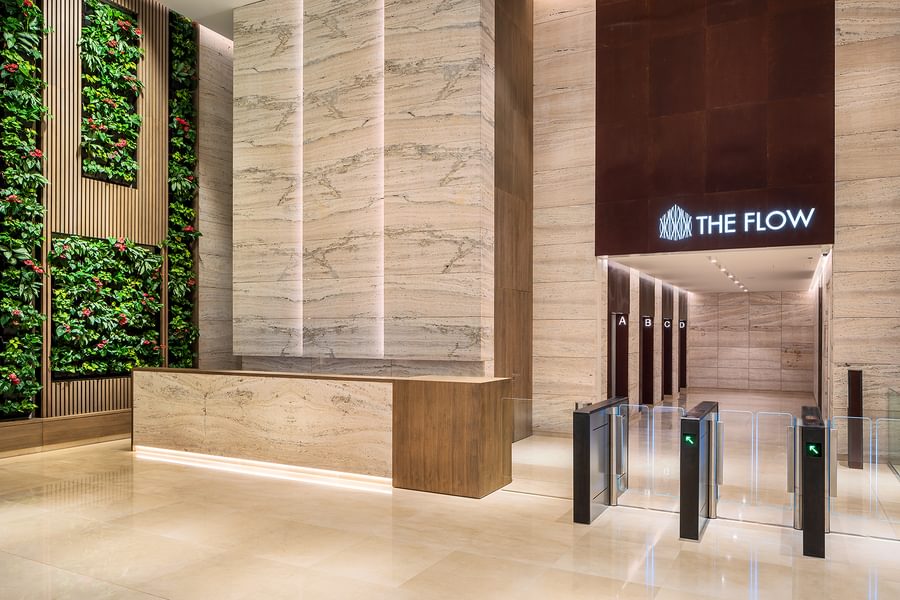
Employing Responsible Design principles on our CEE projects
Chapman Taylor has recently articulated its Responsible Design strategy to reflect the fact that our work involves a much broader vision than just environmental sustainability. The term “Responsible Design” includes the socio-economic implications of our work, covering areas such as designing for the physical and mental wellbeing of people who inhabit and use the spaces we create. Environmental sustainability, particularly features such as energy efficiency and carbon neutrality, remain at the heart of this broader strategy.
Our Prague studio has employed these principles for several years on projects throughout the CEE region, with recently completed examples including Expo Business Park in Bucharest, USĆE Tower Two in Belgrade and The Flow Building in Prague – all setting new standards for Responsible Design. In this article*, Chapman Taylor Group Board Director Jon Hale, Associate Directors Jan Pokorný and Igor Bergmann and Senior Architect Jakub Kučera talk about the elements that ensured these three projects reflected the highest standards of responsible architecture.
Can you give an overview of the Expo Business Park project?
JH: Expo Business Park, designed for developer Portland Trust, is a complex of three buildings (37,500m2 GLA) close to the EXPO area in northern Bucharest. The project occupies a significant corner plot in this rapidly transforming area and the buildings are graduated in height to reflect the scale of the adjacent development from the low-level traditional residential quarter to the east and the newly constructed high-density, high rise, residential zone to the west. The planning constraints were fixed in accordance with the recently approved masterplan and we aimed to create a sustainable project to meet the needs of top international tenants.
IB: Along with high performance glass, we used metal “fins” on the façade to help reduce solar gains by providing additional shading, especially on areas which receive sunlight for long periods. These features extend over two floor levels, bringing a classical proportion to the façade and emphasising the buildings’ vertical dimensions. The interiors are kept simple, with open ceilings in the public areas with suspended circular panels to reflect light to the spaces below while allowing full access to the building services above.
The reception areas in all three buildings are double-height and use a combination of light, large-format ceramics (from floor to ceiling) and white lacquered glass to create bright, welcoming spaces, with easy-to-maintain surfaces. The business park’s street level has attracted a mix of convenience retail, F&B and a fitness centre. The outdoor spaces are popular and busy. A sculpture by the British artist Colin Spofforth picks up on the aviation links to the site.
What energy saving or green features did you incorporate into the building?
JH: We took a broad approach, including the use of quality glazing, internal and external LED lighting and low-water-consumption sanitary fittings, as well as providing facilities for bicycles and charging points for electric vehicles and bikes. We also employed rooftop solar hot water and PV panels. However, our approach goes beyond including just the headline “green” features – designing sustainably informs every aspect of the project through all the design, procurement and construction phases and, more importantly, considering the operational lifespan of the building.
IB: Maximising the use of daylight is very important, as well as optimising the use of greenery on the site. We use extensive soft landscaping at street level, but also on a series of roof terraces that provide amenities for the staff as well the benefits of natural cooling, the retention of rainwater and increased biodiversity. Each of the three buildings at Expo Business Park separately achieved BREEAM Outstanding certification and are the first office buildings in Romania to do so.
JH: Efficiency is just part of the Responsible Design equation. Our designs need to provide attractive and healthy work environments for the buildings’ users. When ING Bank were choosing a new location for their headquarters in Bucharest, their key criteria included wellbeing and the quality of the space, both inside and outside the buildings.
Tell us about UŠĆE Tower Two in Belgrade and some of its atypical design solutions.
JH: This was predominantly a sustainability-led design aimed at creating a landmark development in the city. At a simplistic level, it was designed as a twin for the original UŠĆE Tower dating from the late 1960s, but, conceptually, it’s a radically different building. We reviewed the technical issues that existed with the original tower and aimed to resolve them in completely new ways. We moved the main core to the side of the building, simultaneously providing self-shading on the typically problematic west façade, and in so doing, we freed up the floorplate to allow far more flexible office space and to create the opportunity for cross-ventilation of the office floors.
The planning constraints limited the total floor area within the building, but also fixed the overall height, which gave us the chance to create higher-than-normal offices floors; these are always welcome, but seldom viable. This, together with the open floor plans strengthened the arguments for an effective natural ventilation strategy as well as improving daylight penetration into the building. The additional height allowed us to locate the HVAC equipment above the WC blocks on a floor-by-floor basis, and not centralised on the roof or in the basement. This solution saves on vertical riser space and gives each tenant the maximum control over their own equipment and internal environment, while maintenance is also easy, with minimum disruption to the users.
The cladding of the external core is made from perforated stainless steel which allows daylight in as well as providing shading
JK: The façade incorporates deep vertical lamellas on two sides to further reduce solar gains on the glazing. The side core arrangement also means that the lift lobbies have natural daylight and great views over the city and the surrounding parks. The cladding of the external core is made from perforated stainless steel, which allows daylight in, provides full shading and creates amazing reflections of the surrounding greenery and the sky.
What was your approach to the interiors of Tower Two?
JH: The entrance hall is a generous double-height space incorporating cafes, an exhibition space, a shop and mezzanine conference rooms. We used locally sourced stone on the floor and for cladding the substantial columns. The ceiling is a combination of metal lamellas and a central wave feature, resembling billowing sails, that form a “procession” leading to the lift lobby. By contrast the lift lobbies in the original tower are dark, low, internal spaces, in Tower Two we have high ceilings, natural light and stunning views. The need for artificial light is reduced, except for the evenings.
JK: The office spaces are conceived to have open ceilings– this maximises the ability of the natural ventilation system to remove heat accumulated by the structure while night purge cooling. Night cooling takes a measurable load off the building’s cooling systems on warmer days and helps reduce energy demands, especially in the morning hours. We placed the structural columns away from the corners of the building to create uninterrupted views from the key meeting rooms and offices located in these prime positions.
At roof level, there is a restaurant/café, complemented by greenery, with fantastic views over the confluence of the Sava and Danube rivers in central Belgrade.
JH: The amount of greenery in this part Belgrade is really fantastic. We wanted to reinforce the park-like setting and relocated the original surface-level decked car parking to an extended basement that serves both towers and also connects to the retail parking to accommodate peak weekend overflow, when necessary. The landscaping wraps round the towers and links seamlessly with the UŠĆE Park to the north. The revitalisation of the UŠĆE park was conceived by Jan Gehl Architects and includes new play areas, fitness zones and running and cycle paths. Our landscape proposals are an extension of this green resource and bring an enhanced quality of planting to the office environment.
You took a collaborative approach to the technical solutions?
JH: Having successfully worked with Buro Happold on several occasions, we decided to team with them on the original competition entry for the project. The opportunity to use a façade-integrated natural ventilation system stemmed from the detailed climatic studies that Buro Happold undertook within the feasibility stage. Combined with the side core arrangement and over-height office levels, we realised there were several strong arguments to embrace this approach.
It is clear to us that an integrated, collaborative approach to design is essential to meet the challenges of climate change. We have to consider all the technical possibilities in our projects, working with experienced environmental engineers early in the concept stage to identify the best opportunities.
How did you approach the design of The Flow Building in Prague’s Wenceslas Square?
JP: The Flow Building is in a very prominent position and the design demanded very careful consideration and a lot consultation with a wide range of stakeholders. We took inspiration from the materials and details of some of the surrounding buildings on the square, which we aimed to apply in a totally modern way and at different scales in the design.
The main façade facing Opletalova Street and Wenceslas Square is fundamental to the whole concept. The motifs and technical details help to emphasise the complex geometry, which is curved in two planes – vertically and along the whole length of the façade; it actually arcs continuously from one side of the building to the other. The geometry looks simple and elegant but is very complex and it was technically challenging to achieve this continuous surface using a unitised façade system.
The façades incorporate several technologies to help maintain the internal environment of the building and to minimise energy consumption for heating and cooling. The façade is triple-glazed and, on the most exposed corner, which faces directly south, we used a double-skin construction. This provides additional thermal and acoustic protection to the interior and allowed us to use heat-formed, curved glazing on the outer face, maintaining the exact geometry of the curved surface. The windows are shaded by parametrically controlled external blinds, which are concealed behind travertine-clad enclosures when fully open. The curved feature lamellas incorporate linear LED lights that glow a warm white colour and outline the geometry of the building at night.
How were the interior spaces conceived?
JP: This is a prestigious location and the building has attracted very high-profile tenants. Saving on the interiors was not an option. The common areas of the building are quite limited in scope, so it was important for these to be finished using high-quality and durable materials. While The Flow Building has large glazed areas, the materiality is also defined by the use of stone, but in a very modern way. Within the reception, we have used locally sourced Spišský travertine in its most natural, raw state, as it is found in the ground. The unhewn surface is what is in contact with the surrounding earth and it is considered the most luxurious travertine surface you can have. Each block weighs between 300–500 kg and this finish has only been used a few times in the Czech Republic and Slovakia. Other materials include patinated brass, used above the lift lobby hall, which is repeated around the lift doors and for the floor numbering signage. The reception also features a 7.5m-high green wall, which naturally plays off against the stone.
Can you describe some of Responsible Design solutions used in the building?
JP: There are no boilers in the building, so no local CO2 emissions are being created; energy is provided by electricity, with the aim of always purchasing renewable power, when possible. We are using air source heat pumps to heat and cool the building, along with a VRV-based HVAC system, which allows for efficient zoned temperature control and which uses significantly less energy than a traditional system. In the basement, you can park any type of car, including EVs, CNG or LPG; normally you cannot park them in enclosed car parks, but here we have used special sensors and ventilation systems. The building provides for 56 electric vehicle recharging stations, including three super-chargers. We see the electrification of cars as one of the necessary steps to reducing carbon emissions and improving air quality in the city centre.
JH: Rather than putting a lot of mechanical equipment on the roof, which is typical for office buildings, we located it all internally on three separate levels above the car park access ramp. This keeps the roofline relatively clear and helps reduce noise to the surroundings. There are roof terraces on the two upper levels, from which the views are extraordinary.
We are currently preparing proposals for this fantastic amenity, including the creation of a multi-purpose terrace with relaxed seating zones, a community table, outdoor workplaces and even a yoga corner. The top floor includes a shared space for all the building users, with a coffee bar, lounge seating and events area. This can be used by all the building’s occupants, or even be rented for company parties, and forms part of our client’s commitment to ensuring the wellbeing of all their tenants.
The Flow Building has become the first building in the Czech Republic to achieve a BREEAM Outstanding rating, the highest BREEAM rating, under the latest version of the BREEAM International New Construction scheme. Separate “Outstanding” certificates were awarded for both the office and retail components of the development. This is a testament to the commitment of our client, Flow East, to achieve the very highest standards of Responsible Design.
* This is an abridged and edited version of an interview published in Building World Magazine in September 2020.
Chapman Taylor’s Responsible Design approach can be summarised as: “Designing for the wellbeing of people, places and the planet”. We aim to ensure that our Responsible Design principles are embedded at the outset of every project we undertake in the CEE region and across the world. This is an evolution of the design practices and principles we have developed over the years, but with an added emphasis on, and commitment to, continuous learning and improvement. We think it is important to take a holistic view of what constitutes responsible design and ensure that we integrate industry-leading expertise in every aspect of it.
Photographs credit:
The Flow Building - Flow East and Scott.Weber for the interior view of their workspace
Expo Business Park - Vlad Patru, @vlad.patru, vlad@node.studio
USĆE Tower Two - Milos Nesic, Instagram: @milosnesicstudio











